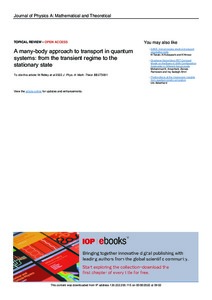A many-body approach to transport in quantum systems: from the transient regime to the stationary state
Lo Gullo Nicolino; Karlsson Daniel; Ridley Michael; Tuovinen Riku; Talarico N Walter
https://urn.fi/URN:NBN:fi-fe2022081154070
Tiivistelmä
We review one of the most versatile theoretical approaches to the study of time-dependent correlated quantum transport in nano-systems: the non-equilibrium Green's function (NEGF) formalism. Within this formalism, one can treat, on the same footing, inter-particle interactions, external drives and/or perturbations, and coupling to baths with a (piece-wise) continuum set of degrees of freedom. After a historical overview on the theory of transport in quantum systems, we present a modern introduction of the NEGF approach to quantum transport. We discuss the inclusion of inter-particle interactions using diagrammatic techniques, and the use of the so-called embedding and inbedding techniques which take the bath couplings into account non-perturbatively. In various limits, such as the non-interacting limit and the steady-state limit, we then show how the NEGF formalism elegantly reduces to well-known formulae in quantum transport as special cases. We then discuss non-equilibrium transport in general, for both particle and energy currents. Under the presence of a time-dependent drive—encompassing pump–probe scenarios as well as driven quantum systems—we discuss the transient as well as asymptotic behavior, and also how to use NEGF to infer information on the out-of-equilibrium system. As illustrative examples, we consider model systems general enough to pave the way to realistic systems. These examples encompass one- and two-dimensional electronic systems, systems with electron–phonon couplings, topological superconductors, and optically responsive molecular junctions where electron–photon couplings are relevant.
Kokoelmat
- Rinnakkaistallenteet [19207]
